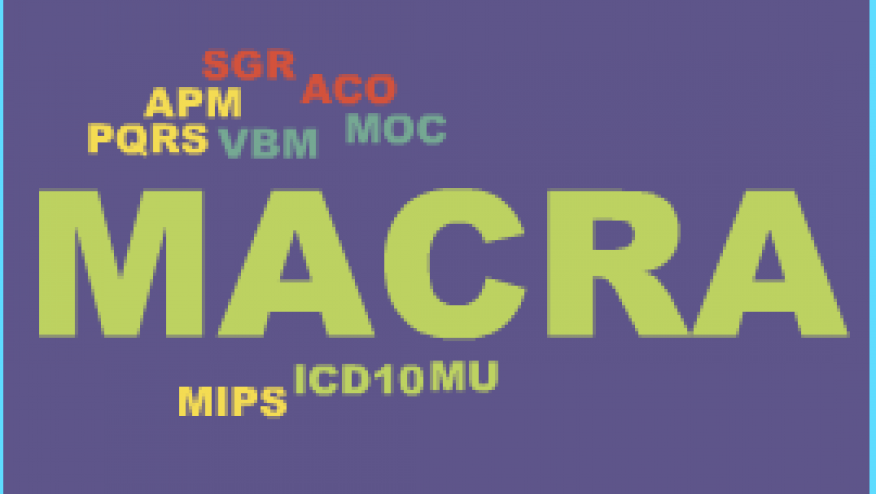MACRA for the Overwhelmed Rheumatologist Save

You are in good company if you find the alphabet soup of rules and regulations impacting your practice a bit overwhelming. MU, ICD10, MOC, VBM, MIPS, APM, PQRS, ACO, SGR...it’s enough to trigger fantasies of early retirement among even young rheumatologists. But don’t despair!
Herein we offer some thoughts to put the MACRA beast into perspective, shine a light on a few key details germane to the practice of rheumatology and point you to the trailhead so that you can join your peers on our next journey through Medicare. Not unlike many of our colleagues, we are a bit jaded by the dense thicket of rules we find ourselves in at present, but we also find reason for optimism.
MACRA, as you probably know by now, stands for Medicare Access and CHIP Reauthorization Act, and was enacted into law in April 2015 with overwhelming support in both houses of congress. It replaced the SGR formula that had been in use by Medicare since 1997 to calculate physician reimbursement and had prompted a last-minute “doc fix” every year since 2003. Like all broad policy changes, the passage of MACRA into law represented the end of only the first phase of sausage making. Phase two, the conversion of legislation into regulation, is currently underway at CMS.
MACRA represents a big change. It will have more impact on the way you practice medicine than did the Affordable Care Act, and will cause more angst than meaningful use or ICD10. Its overarching goal is nothing short of transformational: to move doctors from fee-for-service to a payment system based on value (loosely defined as quality divided by cost).
We’ll save a deeper dive into the existential implications of MACRA for others (or until you buy us a beer at the ACR meeting). For now, here is what you need to know to get started:
- The fun starts on Jan 1, 2017. What’s that? You thought MACRA started in 2019? Well, newly calculated payments start in 2019, but the performance metrics, upon which your 2019 reimbursement will be based, are drawn from the calendar year two years prior. So, your journey starts soon. (Yes, rumors are flying about delayed start – stay tuned.)
- If you want to get paid for seeing Medicare patients, you must chose one of two paths. Option A is known as MIPS. It’s a zero-sum cage match that pits doctor against doctor, merges familiar pay-for-performance metrics (MU, PQRS, VBM) under one umbrella and adds a couple of twists. Importantly, for every dollar rewarded as a bonus payment to high-performing physicians under MIPS, a dollar will be withheld as a penalty from the physicians who score below the median performance threshold. That, by definition, means half of us lose and half win. Which side will you be on?
If you do nothing, you’ll be in MIPS. And this is important because CMS estimates that the vast majority of physicians will choose MIPS in the beginning, and that many who score below the benchmark will do so simply by virtue of not reporting. Therefore, for the first year or two anyway, the relatively simple (ahem) act of reporting will likely confer a significant advantage.
There are a number of ways you can report under the MIPS pathway, including through your EMR, through the GPRO site, or through a qualified clinical data registry. Many of you are familiar with the Rheumatology Clinical Registry from the ACR which allowed manual reporting to CMS. Now, The Rheumatology Information System for Effectiveness (RISE) brings a fully automated platform for measuring practice performance and MIPS reporting. As a qualified clinical data registry RISE, with no charge from the ACR, can support practice activities without the need for data entry, linking seamlessly with your EMR. The data sent to RISE is anonymized and none of it goes to CMS, only summary data reporting your performance. There are other registries out there, but RISE is the only one designed by and for rheumatologists. Not only can it be used for reporting, it also gets you points in all MIPS categories.
Option B is to create or join an APM. Our thinking on alternative payment models is influenced by Harold Miller, CEO of the Center for Healthcare Quality and Payment Reform. He urges physicians to think about APMs as belonging to one of two broad categories: those created by payers (including ACOs) and those that are physician-focused.
Surprisingly, given the overarching goal of MACRA, payer-designed APMs continue to pay hospitals and doctors on a fee-for-service basis. But they layer on “shared savings” (or sometimes bonuses) as an incentive to reduce costs. In these programs, organizations that successfully lower the cost of care of a group of patients will share in the savings. (Attribution, determining which doctor is responsible for a given patient, is one of the details wherein many devils lie.) ACOs are the most widely recognized type of APM, but several others exist. Importantly, for an APM to qualify under MACRA, the carrot of shared savings must be combined with the stick of shared risk. As currently implemented, most ACOs do not impose enough risk to qualify as an APM under MACRA.
The development of physician-focused APMs is a requirement of the legislation that created MACRA, but to date no physician-focused APMs relevant to subspecialists have matured to the point of implementation. CMS has the final say as to whether a physician-focused APM will qualify under MACRA, but an important committee known as PTAC, which is independent of CMS, will have significant influence on CMS’s decisions along these lines. The physician-focused APMs currently under development would offer substantial benefits to providers but require a significant investment in development costs and run the risk that they may never pass muster with CMS.
In spite of these risks, this is where the optimists among us see reason for hope. Imagine you were rewarded for your ability to diagnose RA more quickly than a generalist. Imagine being paid to keep slots open on your schedule for urgent visits. Imagine the freedom to innovate with email and smart phones to improve care as opposed to these tools being forced on you as unpaid mandates. Imagine reading a note that contained only the information deemed important by the physician, without page after page of auto-populated tables that you have to scroll past “like a raccoon foraging in a dumpster” (as one of our colleagues put it).
These horizons are still off in the distance, but we are truly at a singular moment in that we have an opportunity to create the paths to get there.







If you are a health practitioner, you may Login/Register to comment.
Due to the nature of these comment forums, only health practitioners are allowed to comment at this time.